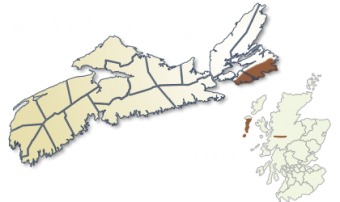![]()
An Drochaid Eadarainn Tha i seo 'na làraich-lìn a sholaraicheas dorust fosgailte do dhualchas beò na Gàidhlig mar a chìthear, a chluinnear 's a chleachdar a' là an-diugh ann an Gàidhealtachd na h-Albann Nuaidh.

Thòisich na Gàidheil air àite a dhèanamh dhaibh-fhéin air taobh an ear-dheas Cheap Breatuinn tràth `s an naoidheamh linn deug. Thàinig grunn mór dhiubh às Uibhist a Tuath, Bearnaraidh na Hearadh is Eilean Leòdhais. Bha coimhearsnachd ann cuideachd aig na Deasaich is na Mòraraich a sheitlig air taobh tuath Abhainn Mhira. Gheobhar caochladh dhualchainntean a's a’ cheàrnaidh seo a nì fianais air cho dlùth, teann `s a bha na coimhearsnachdan a bhos ris na h-àiteachan a dh’ fhàg iad thall. Ged a tha teaghlaichean ann a bha ainmeil airson an cuid phìobairean is fhìdhleirean, `s e fìor dheagh sheinneadairean is bàird as moth' a chomharraicheas coimhearsnachdan mar a tha Loch Laomainn, Gabarus is Catalone. Tha sinne fad' an comain nan Gàidheal às a’ cheàrnaidh seo do Cheap Breatuinn airson na dìleib luachmhoir `s a bhitheas iad a’ toirt seachad dhuinn chun a’ là an diugh.
Neach-aithris: Seumas Watson
Gaelic culture in the South and Eastern regions of Cape Breton Island is coloured strongly by the traditions of Gaels who emigrated in the early to mid 1800s primarily from the islands of North Uist, Berneray, Harris and Lewis. Substantial South Uist/Morar settlements were also formed around Grand Mira. To this day, the Gaelic spoken in these regions reflects the diversity of Highland communities from which the fore-bearers of Nova Scotia Gaels emigrated. While a rich instrumental tradition existed in certain regions such as the French Road, near Grand Mira, other districts such as Loch Lomond, Gabarus and Catalone are perhaps best represented by Gaelic singing and song composition. Humorous compositions, milling songs as well as hymns and precenting of psalms have been commonly found amongst Gaels from these regions. Indeed, it can be said that the Protestant tradition of reading from the Bible and hymn books/psalters, contributed greatly to the literacy of many eastern Cape Breton Gaels. We are grateful to the Gaels of this region of Cape Breton for the legacy of song and story they have left and continue to celebrate to this day.
SUD-EST DU CAP-BRETON
La culture gaélique des régions du sud et de l’est du Cap-Breton est fortement influencée par les traditions des Gaëls qui ont émigré dans la première moitié du XIXe siècle des îles de North Uist, Berneray, Harris et Lewis. Des établissements importants d’immigrés de South Uist/Morar se sont également formés aux alentours de Grand Mira. Aujourd’hui encore, le gaélique que parlent les habitants de ces régions illustre la diversité des communautés des Highlands d’où les ancêtres des Gaëls de la Nouvelle-Écosse ont émigré.
Il existe une riche tradition de musique instrumentale dans certains secteurs, comme French Road, à proximité de Grand Mira. Dans d’autres circonscriptions, comme Loch Lomond, Gabarus et Catalone, les traditions les plus représentatives sont celle du chant et de la composition de chansons en gaélique. On trouve couramment chez les Gaëls de ces régions des compositions humoristiques, des chansons de foulage, des hymnes et des psaumes chantés. On peut dire, en effet, que la tradition protestante de lecture de la Bible et des hymnaires/psautiers a joué un rôle considérable dans l’alphabétisation de nombreux Gaëls de l’est du Cap-Breton. Nous sommes reconnaissants aux Gaëls de cette région de l’héritage de chansons et de récits qu’ils nous ont légué et qu’ils continuent de célébrer aujourd’hui.
![]()
An Drochaid Eadarainn Tha i seo 'na làraich-lìn a sholaraicheas dorust fosgailte do dhualchas beò na Gàidhlig mar a chìthear, a chluinnear 's a chleachdar a' là an-diugh ann an Gàidhealtachd na h-Albann Nuaidh.